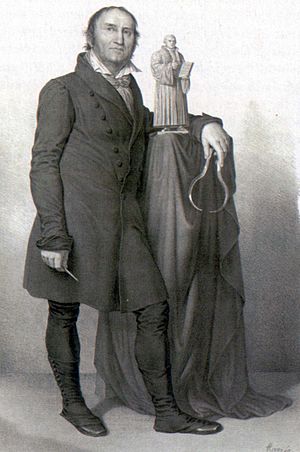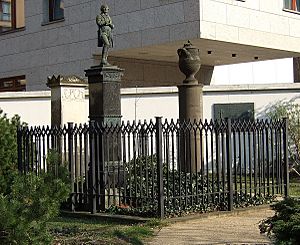Johann Gottfried Schadow facts for kids
Johann Gottfried Schadow (born May 20, 1764 – died January 27, 1850) was a famous German Prussian sculptor. He created many important artworks, especially statues.
One of his most famous works is the amazing chariot statue on top of the Brandenburg Gate in Berlin. He made this when he was only 29 years old in 1793.
Contents
Life of Johann Gottfried Schadow
Schadow was born in Berlin. His father worked as a tailor. From a young age, Schadow showed a talent for art.
Early Training and Travel
He learned how to be a sculptor from Antoine Tassaert. Tassaert was supported by Frederick the Great, a powerful king. Schadow later traveled to Rome, Italy, where he married Marianne Devidel.
While in Rome, he won a special prize for sculptors in 1786. He was also inspired by another famous sculptor named Antonio Canova.
Return to Berlin and Major Works
Schadow came back to Berlin in 1788. He took over Tassaert's job as the main sculptor for the royal court. He also became a secretary at the Prussian Academy of Arts.
His first big project after returning was a tomb for Prince Alexander von der Mark. This prince was the son of King Friedrich Wilhelm II. Over his long career, Schadow created more than 200 artworks.
Famous Statues and Busts
Schadow made many important statues of famous people. These include:
- A statue of Frederick the Great in Stettin.
- A statue of Blücher in Rostock.
- A statue of Luther in Wittenberg.
His statues of Frederick the Great with dogs were very popular. Another famous work is the Princess Monument. This statue shows Princess Louise and her sister Frederica. Many copies of this statue were made.
Schadow also created over 100 busts, which are sculptures of a person's head and shoulders. Seventeen of these large busts are in the Walhalla in Ratisbon. He sculpted busts of famous writers and thinkers like Goethe and Wieland.
Artistic Style and Influence
Schadow is known for his classical style. This means his art often looked like ancient Greek or Roman sculptures. The chariot on the Brandenburger Tor is a great example of this. He also made a detailed frieze (a long band of sculpture) for the Royal Mint in Berlin.
As the director of the Berlin Academy, Schadow had a big impact on art. He wrote books about how to draw the human body correctly. He also studied how different people's faces look. He even drew Harry Maitey, who was the first Hawaiian person to visit Prussia.
Today, you can see some of Schadow's sculptures and busts in museums in Berlin. These include the Friedrichswerdersche Kirche and the Alte Nationalgalerie.
Friendship with Goethe
Schadow became friends with the famous writer Johann Wolfgang von Goethe. Schadow even made 12 bronze medals featuring Goethe's image. One of these medals is kept at the British Museum.
Schadow passed away in Berlin in 1850. His sons, Rudolph and Friedrich Wilhelm, also became famous artists. Rudolph was a sculptor, and Friedrich Wilhelm was a painter.
Images for kids
-
The Prinzessinengruppe: Schadow's famous statue of Friederica (right), with her sister, Louise.
Family
Schadow was the uncle of another sculptor named Emil Wolff.
See also
 In Spanish: Johann Gottfried Schadow para niños
In Spanish: Johann Gottfried Schadow para niños








